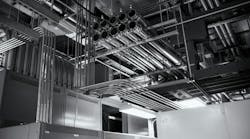Boasting a population of almost 3 million, St. Louis is America's 16th largest city. To help safeguard its citizens' health, the metro area recently opened the doors of the SSM St. Clare Health Center, a $236-million acute care facility that marks St. Louis County's first new hospital in almost 35 yr.
Located on a 54-acre campus in the suburb of Fenton, Mo., the 4-story, 430,000-sq-ft structure features: 154 all-private patient/family suites, each equipped with a mini refrigerator, TV/DVD entertainment center, and a nursing desk located immediately outside the door; 30 emergency services exam rooms; eight operating rooms; 12 labor delivery recovery postpartum (LDRP) patient suites; and 10 OB/GYN patient suites. The building also incorporates sustainable elements, such as daylight harvesting, occupancy sensors, motion detectors, and HVAC control systems.
As with many projects of this scope, the SSM St. Clare Health Center called for extensive pre-construction planning, including the use of 3-D modeling.
“During pre-construction, we used 3-D modeling within a Web-based server system that allowed real-time design/engineering of MEP systems,” says Steve Kellenberger, director of construction for St.-Louis based Guarantee Electrical Co., the hospital's electrical design assist contractor that installed all the power, lighting, emergency, data, fire alarm, and security systems.
According to Kellenberger, 3-D modeling minimized space conflicts and provided a detailed visual perspective.
“This was particularly beneficial while laying out electric, mechanical, and above-ceiling spaces where physical space was limited,” he notes. “Engineering staffs were assembled at the project site, which improved communications and allowed immediate access to the field installation drawings being generated.”
In addition, the hospital owner asked Guarantee to apply “lean construction” principles during the building process. The goal of lean construction is to use less of everything (such as cost, green space, design/construction time, and materials) while better meeting customer — or, in this case, patient — needs.
“Lean construction principles allowed us to integrate Guarantee's proprietary ‘constructability’ model into the project,” says Kellenberger.
The constructability model calls for the company's engineering staff to assemble all information pertaining to a specific area, coordinate the installation with other trades, and then produce daily field installation drawings.
“Larger projects like St. Clare demand this level of engineering to accurately communicate and simplify the plethora of engineering information before it's issued to the field installation crews,” explains Kellenberger. “One benefit is that we can issue accurate as-built or record drawings that reflect the actual installation with no additional engineering time required.”
To keep the hospital's construction time line on target, Guarantee performed as much assembly work as possible off-site.
“As with most construction sites, space was limited,” says Kellenberger. “Therefore, we took advantage of our prefab operation. This proved very beneficial, because it enabled us to start and partially complete work well before final installation deadlines. The constructability model went hand-in-hand with the prefab operation, improving accuracy, efficiency, and schedule performance — not to mention the added bonus of less material waste cluttering up the site.”
The SSM St. Clare Heath Center opened on schedule, welcoming its first patients on March 30, 2009 — two years and three months after it first broke ground.
“The hospital is not only a state-of-the-art facility, it's also easily accessible and has the ability to expand as necessary,” adds Kellenberger. “We're proud to have been selected as a key participant in its creation.”




